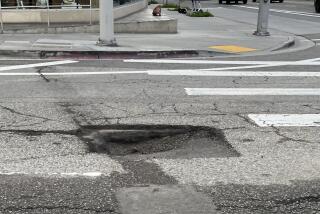Mayor Villaraigosa’s 30/10 plan: Moving forward
- Share via
The 30/10 transit plan is the most important initiative ever proposed by Mayor Antonio Villaraigosa. If, as seems increasingly likely, it’s embraced by Congress, it will become one of the nation’s most significant public infrastructure projects..
Essentially, 30/10 proposes leveraging the half-cent sales tax increase to which 68% of Los Angeles County residents agreed when they passed Measure R with federal loans secured by those tax revenues. Those loans would allow the Metropolitan Transportation Authority to build the 12 crucial projects specified in the measure in just 10 years rather than the projected 30.
When Villaraigosa first proposed 30/10 last fall, it seemed like the longest of shots, but his tireless lobbying — and the initiative’s self-evident merits — won over powerful congressional allies, particularly Rep. Jane Harman (D-Venice) and Sen. Barbara Boxer (D-Calif.), who chairs the Senate Committee on Environment and Public Works, as well as Transportation Secretary Ray LaHood. In fact, 30/10 is one of those ideas that gets better under close examination. Consider, for example, that completion of the 12 transit projects would reduce annual particulate emissions by at least 500,000 pounds, reduce annual gasoline consumption by 10.3 million barrels and, by conservative estimates, cut automobile travel by 208 million miles each year.
Over the next decade, it also will create at least 166,000 well-paying construction jobs.
That hasn’t been lost on the Obama administration, which continues to struggle under the burden of intractable unemployment. As Supervisor Zev Yaroslavsky put it when the MTA board unanimously voted to back Villaraigosa’s initiative: “You can’t turn the economy of this nation around unless you turn around the economy of California. The antidote to the recession is the 30/10 plan. It’s a huge investment in jobs right now.... We’re ready to do it, and we’re ready to pay for it.”
In fact, in a recent conversation with the mayor, President Obama called the proposal “a template for the nation.”
It is, however, still an innovation, and Congress needs to approve a novel way of funding it. Late last week, Washington took two long steps in that direction. On Thursday, LaHood wrote to Boxer, promising that the administration would include 30/10 funding “in the next transportation reauthorization bill.” The senator also said that LaHood already is “working with me on finding every opportunity under current law so we can accelerate 30/10 now.” Equally important, Boxer announced that the Federal Transit Administration, which also reports to LaHood, has agreed that, for funding purposes, it will accept a single environmental review for the entire 9.3-mile subway extension west under Wilshire Boulevard rather than the three different assessments the project normally would require.
“That’s a big deal,” said Deputy Mayor Jaime de la Vega. “Now we can treat the whole extension as one project as we should … and the savings will be huge.” According to De la Vega, construction bids submitted in anticipation of 30/10’s accelerated schedule are coming in 15% to 30% under projected costs for Measure R’s 12 projects. “With those savings, we actually could build more transit” than the ballot proposition included, he said.
“Eight months ago, people in Washington thought we were nuts,” Jeff Carr, Villaraigosa’s chief of staff, told The Times this week. “Now, the feds have come around to seeing this as a model for the nation.” In fact, LaHood told Boxer in his letter that he shares her belief “that the 30/10 model — leveraging a comprehensive long-range transportation plan and a sustainable local funding stream — has the potential to transform the way we invest in transportation projects across the nation.”
Carr and De la Vega point out that this isn’t the first time Los Angeles has been at the cutting edge of transit funding. The Alameda Corridor — the dedicated 20-mile rail line that now links the busy ports of San Pedro and Long Beach to the intercontinental railway line east of downtown — was first conceived by local planners and officials in the early 1980s. They began piecing together rights of way, but it took until 1997 for Congress to pass the Transportation Infrastructure Finance and Innovation Act, which gave the project what it needed: federal loan guarantees secured by the corridor’s future revenues.
Measured against that history, 30/10 has moved forward at the speed of light. Perhaps that’s because, as Carr put it, “It’s good policy and good politics.” How often can you say that?
More to Read
Sign up for Essential California
The most important California stories and recommendations in your inbox every morning.
You may occasionally receive promotional content from the Los Angeles Times.













